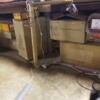I understand evaluating and keeping boxes for vintage trains.
But...
All of my layout is new, so it will be quite some time before they are considered valuable to someone else.
I'm running out of storage room for all of the boxes and right now I still keep all of 'em, however there has to be point you reach where one has to let some go into the circular file.
Finally, a few years back I sold 10 assorted engines at a family estate sale to 1 person for a tidy sum, and they didn't take the boxes which also contained the instructions. Obviously the boxes weren't important to him.








